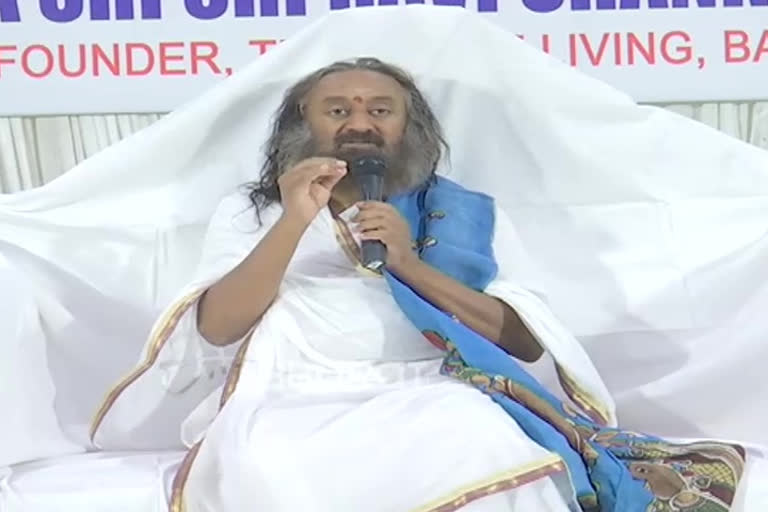ప్రకృతితో మమేకమయ్యే.. మనిషి జీవితం ముందుకు సాగాలి తిరుపతిలో ఓ ప్రైవేటు హోటల్ లో ఆర్ట్ ఆఫ్ లివింగ్ తిరుపతి శాఖ కార్యక్రమం నిర్వహించింది. ముఖ్యఅతిథిగా వ్యవస్థాపకులు శ్రీశ్రీ రవిశంకర్ హాజరయ్యారు. తిరుపతి ఎమ్మెల్యే భూమన కరుణాకరరెడ్డి, తితిదే ఛైర్మన్ వైవీ సుబ్బారెడ్డి రవిశంకర్ను మర్యాదపూర్వకంగా కలిసి ఆశీర్వచనం అందుకున్నారు. ప్రకృతితో మమేకమయ్యే.. మనిషి జీవితం ముందుకు సాగాలని రవిశంకర్ సందేశమిచ్చారు. సరైన ఆహార నియమాలు పాటించకపోవటంవల్లే... మనిషి ప్రవర్తనలో మార్పులు వస్తున్నాయన్నారు. ధ్యానం ద్వారా మెరుగైన ఏకాగ్రత...శాంతిని పొందవచ్చని సందేశమిచ్చారు.
Intro:Body:
BLUE REVOLUTION TAKES WINGS
Aquaculture plays an important role in Indian rural economy. This industry is recording good profits every decade. China is the largest exporter of fish and fish products. India stood second by exporting Rs. 37,870 crore worth aqua products in 2016-17 and Rs.45,000 crore worth products in 2018-19. Our country has ample resources for expanding our exports in the coming years. Realizing this potential, the government is getting ready for Blue Revolution 2.0. As a part of this revolution, central government has released funds worth Rs.25,000 crore to the aqua industry. These funds will be utilized within 3-5 years in various sectors of the industry. Rajni SekhriSibal, Secretary of Department of Fisheries stated that the funds will be put to use for creation of basic facilities in shipyards, modern technologies in hatcheries and processing units and providing amenities for cold chains.
The Indian government has first proposed Blue Revolution during the 7th five-year plan (1985-90). New methods of increasing fish and other marine produce were introduced. From fish breeding to marketing, farmers were made aware of novel practices. Exports were also encouraged. Owing to all these, the first revolution was successful. Recently, government has introduced various welfare schemes under the umbrella of Blue Revolution. Rs.1,491 crores have been released for the development activities from 2015-16 to date. The aim is to increase aqua production to 1.50 crore tonnes by 2020 and to 2 crore tonnes by 2022-23. Advanced technology and private investments will be the points of focus. The central government has set the target of producing Rs.4,50,000 crores worth aqua products by 2030. This is ten times the current production.
The fishing industry employs 1.40 crore people nationwide. Fisheries constitute 1% of India’s total GDP. India exports more than 50 kinds of fish, shrimp, prawns and crabs to about 75 countries around the world. Fish and fish products constitute 10% of the total exports and 20% of agriculture related exports. India is the largest exporter of prawn and shrimp. India has a coastline of 8,129 km. Fishermen and aqua farmers are spread over 3,827 villages all over the country. 1,914 traditional fish landing centres are established to date.
India accounts for 6.3% of the global fish production. Fisheries sector is growing at the rate of 7%. Fish like See bass, Grey mullet, Katla, Rohu and ornamental varieties; prawns, shrimp, crabs and oysters are being produced in our country. Katla, Mrigal and Rohu amount to 87% of freshwater fish production. During 2017-18, 32.76% of marine produce was exported to USA, 21.59% to Southeast Asia, 15.77% to Europe, 6.29% to Japan 4.10% to Middle East and 3.21% to China. Owing to exports of Black Tiger fish and Vannamei prawn, there was a profit of Rs.22,000 crores to the economy. 12 lakh hectares of brackish waters are suitable for aquaculture. Besides this, 20 lakh square km of Exclusive Economic Zone is available.
It is imperative for the industry to develop diverse aqua products. When the fisheries industry took a hit in Europe, new varieties of fish were bred to save the industry. Indian government is giving importance to breeding diverse fish breeds to increase the profits. Fish seeds must be purchased from the right breeders in order to achieve high quality marine produce. Storage and Supply processes must adhere to International standards. Cold chain system will help prevent losses. Cloud computing will aid in fast transportation. Biosensors and satellite technology are being used to detect the occurrence of fish in oceans and climate changes. This information must be available to fishermen as well. The main objective of Blue Revolution 2.0 is to increase profits for aqua farmers and fishermen by increasing the produce. Although resources are aplenty, farmers are able to utilize only 14% of them. The government is aiming for total utilization of resources while taking into consideration, environmental sustainability. 9.40 lakh jobs are going to be created additionally in this sector. Special training is being given to deep-sea fishermen. Rs. 12.55 crores are allocated for these activities, providing assurance to farmers and fishermen by eliminating middlemen. Marine Products Export Authority (MPEA) is conducting awareness programs in villages. MPEA conducts quality testing before and after fish harvesting. It is working towards elimination of antibiotics and other toxic residues under National Residue Control Program. It established 506 state of the art processing plants through which 23,000 tonnes of marine produce could be achieved. 62% of these have been approved by European Union.
There is a common notion among people that pisciculture means unhygienic conditions, low-grade products, toxic food and usage of antibiotics and steroids. The concerned ministry must take measures to certify that the quality of products in order to increase consumer trust. Small scale fishing centres must be encouraged across the length of coastline. Small scale industries account for 90% of fisheries business worldwide. The government must allocate funds for research and development. Innovative ideas and technologies must be welcomed and made available to all. If the government sincerely follows through these steps, everyone will benefit from the Blue Revolution 2.0.
Conclusion:



